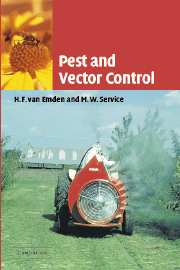Apple, J. L. and Smith, R. F. (eds.) (1976). Integrated Pest Management. Plenum, New York
Axtell, R. C. (1979). Principles of integrated management (IPM) in relation to mosquito control. Mosquito News, 39, 709–18
Beales, P. and Gilles, H. M. (2002). Rationale and techniques of malaria control. In: Essential Malariology (eds. Warrell, D. A. and Gilles, H. M.), pp. 107–90. Edward Arnold, London
Beaty, B. J. and Marquardt, W. C. (eds.) (1996). The Biology of Disease Vectors. University of Colorado, Colorado
Birch, M. C. and Haynes, K. F. (1982). Insect Pheromones. Studies in Biology, no. 147. Edward Arnold, London
Burges, H. D. (ed.) (1981). Microbial Control of Pests and Plant Diseases 1970–1980. Academic Press, London
Burn, A. J., Coaker, T. H. and Jepson, P. C. (eds.) (1987). Integrated Pest Management. Academic Press, London
Carson, R. (1962). Silent Spring. Houghton Mifflin, New York
Clark, G. C. (coordinator) (1994). Special Symposium on Vector Control. American Journal of Tropical Medicine and Hygiene, 50 (supplement), 1–159
Copping, L. G. (ed.) (2001). The Biopesticide Manual, 2nd edn. British Crop Protection Council, Farnham
DeBach, P. (ed.) (1964). Biological Control of Insect Pests and Weeds. Chapman and Hall, London
Dent, D. (2000). Insect Pest Management, 2nd edn. CABI, Wallingford
Doutt, R. L. (1958). Vice, virtue and the vedalia. Bulletin of the Entomological Society of America, 4, 119–23
Eldridge, B. F. and Edman, J. D. (eds.) (2001). Medical Entomology. A Textbook on Public Health and Veterinary Problems Caused by Arthropods. Kluwer, Dordrecht
Emden, H. F. (1969). Plant resistance to aphids induced by chemicals. Journal of the Science of Food and Agriculture, 20, 385–7
Emden, H. F. (1983). Pest management – routes and destinations. Antenna, 7, 163–8
van Emden, H. F. (1987). Cultural methods: the plant. In: Integrated Pest Management (eds. Burn, A. J., Coaker, T. H. and Jepson, P. C.), pp. 27–68. Academic Press, London
van Emden, H. F. and Peakall, D. B. (1996). Beyond Silent Spring: Integrated Pest Management and Chemical Safety. Chapman and Hall, London
Flor, H. H. (1942). Inheritance of pathogenicity in Melampsora lini. Phytopathology, 2, 653–69
Gubler, D. J. and Kuno, G. (eds.) (1997). Dengue Fever and Dengue Hemorrhagic Fever. CABI, Wallingford
Hadaway, A. B. and Barlow, F. (1951). Studies on aqueous suspensions of insecticides. Bulletin of Entomological Research, 47, 603–22
Hay, S. I., Randolph, S. E. and Rogers, D. J. (eds.) (2000). Remote sensing and geographical information systems in epidemiology. Advances in Parasitology, 47, 1–357
Hill, D. (1975). Agricultural Insect Pests of the Tropics and their Control. Cambridge University Press, Cambridge
Knipling, E. F. (1955). Possibilities of insect control or eradication through the use of sexually sterile males. Journal of Economic Entomology, 48, 459–62
Laird, M. and James, J. W. (eds.) (1983). Integrated Mosquito Control Methodologies, vol. 1. Academic Press, London
Laird, M. and James, J. W. (eds.) (1985). Integrated Mosquito Control Methodologies, vol. 2. Academic Press, London
Lane, R. P. and Crosskey, R. W. (eds.) (1993). Medical Insects and Arachnids. Chapman and Hall, London
Matthews, G. A. (2000). Pesticide Application Methods, 3rd edn. Blackwell Science, Oxford, and Longman, New York
Maxwell, F. G. and Jennings, P. R. (eds.) (1980). Breeding Plants Resistant to Insects. John Wiley, New York
Morgan, R. (ed.) (1992). The BMA Guide to Pesticides, Chemicals and Health. Edward Arnold, London
Mullen, G. and Durden, L. (2002). Medical and Veterinary Entomology. Academic Press, Amsterdam
Painter, R. H. (1951). Insect Resistance in Crop Plants. Macmillan, New York
Panda, N., Khush, G. S. and Panda, K. (1997). Host Plant Resistance to Insects. CABI, Wallingford
Pimentel, D. (ed.) (2002). Encyclopedia of Pest Management. Marcel Dekker, New York
Rabb, R. L. (1970). Introduction to the conference. In: Concepts of Pest Management (eds. Rabb, R. L. and Guthrie, F. E.), pp. 1–15. North Carolina State University Press, Raleigh
Ripper, W. E. (1955). Application methods for crop protection chemicals. Annals of Applied Biology, 42, 288–334
Ripper, W. E. (1956). Effect of pesticides on balance of arthropod populations. Annual Review of Entomology, 1, 403–38
Rozendaal, J. A. (prepared by) (1997). Vector Control. Methods for Use by Individuals and Communities. World Health Organization, Geneva
Samways, M. J. (1981). Biological Control of Pests and Weeds. Studies in Biology no. 132. Edward Arnold, London
Schoeler, G. B. and Wikel, S. K. (2001). Review. Modulation of host immunity by haematophagous arthropods. Annals of Tropical Medicine and Parasitology, 95, 755–71
Service, M. W. (1993). Review. Community participation in vector-borne disease control. Annals of Tropical Medicine and Parasitology, 87, 223–34
Service, M. W. (ed.) (2001). Encyclopedia of Arthropod-transmitted Infections of Man and Domesticated Animals. CABI, Wallingford
Service, M. W. (2002). (reprint). Medical Entomology for Students, 2nd edn. Cambridge University Press, Cambridge
Southwood, T. R. E. (1973). The insect/plant relationship – an evolutionary perspective. In: Insect/Plant Relationships (ed. van Emden, H. F.), pp. 3–30. Blackwell, Oxford
Southwood, T. R. E. (1975). The dynamics of insect populations. In: Insects, Science and Society (ed. Pimentel, D.), pp. 151–199. Academic Press, New York
Stern, V. M., Smith, R. F., Bosch, R. and Hagen, K. S. (1959). The integration of chemical and biological control of the spotted alfalfa aphid: the integrated control concept. Hilgardia, 28, 81–101
Tomlin, C. (ed.) (2000). The Pesticide Manual, 12th edn. British Crop Protection Council, Farnham
Van Driesche, R. G. and Bellows, T. S. (1996). Biological Control. Chapman and Hall, New York
Wall, R. and Shearer, D. (2001). Veterinary Ectoparasites: Biology, Pathology and Control, 2nd edn. Blackwell Science, Oxford
Way, M. J.andvan Emden, H. F. (2000). Integrated pest management in practice – pathways towards successful application. Crop Protection, 19, 81–103
World Health Organization (1982). Manual on the Environmental Management for Mosquito Control: with Special Emphasis on Malaria Vectors. Offset Publication no. 66. World Health Organization, Geneva
World Health Organization (1983). Integrated vector control. Seventh Report of the WHO Expert Committee on Vector Biology and Control. Technical Report Series, 688





